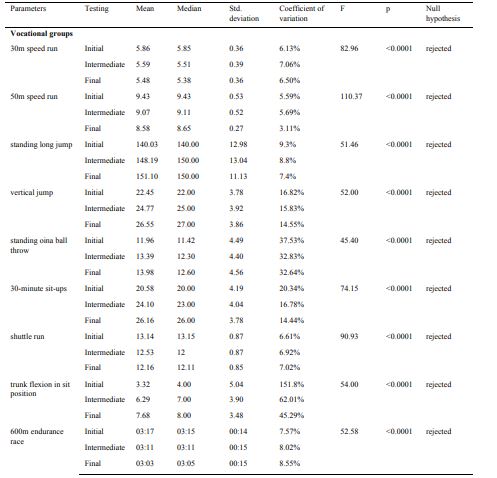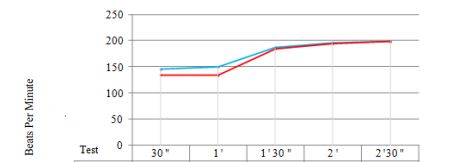Study about the Improvement of Motor and Functional Potential in Children Aged 6 to 9 Years Using the Means of Athletics
Abstract
We are being witnesses of a phenomenon involving a decrease in the average age of Olympic and World champions and implicitly a new trend of sports debut at an early age, because achieving performance at the world level requires at least 8 years of training. Globally, there is a trend to start selection at younger ages in most sports branches, which has determined a new perspective in athletics too, as regards the debut of selection and instruction. Because the athletic performance involves a long period of preparation and a high volume and intensity of exercise, the age of initial selection is recommended to decrease up to 6-7 years, so that to insure a gradual, progressive development of the systems and thus the biological factors required for performance can be raised to a superior level. Obviously, there have been enough controversies related to decreasing the age of debut in athletics. In this regard, the present study aims to investigate the possibilities of improving the motor and functional potential of children aged 6 to 9 years using the emulative-playful athletic means. The study was conducted in the school year 2012-2013 at the Elementary School no. 190 of Bucharest, on classrooms with an athletics sports profile. To assess the children’s motor and functional potential, functional measurements and motricity trials were performed during initial, intermediate and final testing. Analysis of the processed results has revealed an improvement in the motor parameters of children aged 6 to 9 years, but not in the functional parameters.
Keywords: Motor potential, athletics, motor qualities, early training, pre-puberty age
1. Introduction
It is known that movement is the engine of all things and it is crucial in the childhood period.
Movement is the essential characteristic of the animal world; for humans, and especially for children,
movement is as vital as food and water, representing the motive through which they satisfy their needs,
fulfil their desires and reach their personal goals.
Underlying the importance of movement, Piaget (2011) noted that, during the feeding activity, only
the movement is observed. Motor activity is the main form through which the child explores the world
and which will constitute the fundamentals of future activities.
What is important to highlight that not only the age determines the emergence and acquisition of
motor behaviour, but also the child’s motor experience plays an essential role.
The healthy child has all that it is necessary, under the physiological and psychological aspects, to
achieve, at a good level of execution, fundamental motor behaviours. It is sufficient if the parents
create favourable conditions for the children and provide them all the attention and time needed to
express their motor potential. If motivated and encouraged by the entourage, the child learns quickly
and easily not only the natural movement, but also more complex forms of activity.
Hence the importance of early instruction under the guidance of a careful and well-informed
teacher, whose priority is represented by the acquisition of fundamental motor behaviours through
various games and challenges adapted to the age and level of development.
Harre (cited by Nicu, 1993: 105-106) lists the following principles of sports training: principle of
accessibility, principle of continuous effort, principle of periodization and cyclic structure of effort,
principle of conscious participation of a systematic insight, individualization and thorough knowledge.
Early instruction in athletics aims to check some principles of educational intervention at the pre-
pubertal age, such as: multilateral preparation, exploring and experiencing as many forms of
fundamental motor behaviours as possible, encouraging the association of various motor behaviours,
thus combining running, jumping, throwing, changes of position, etc.
Due to the awareness at the micro level of the beneficial effects of sports on children, we notice the
parents’ tendency to enrol their children in sports clubs at an early age, hence the need for the early
assimilation of instruction in athletics, because otherwise this sport would considerably limit its
selection area. “Early detection of youth with particular motor potencies brings a guarantee that the
optimal moment of initiation will not be lost, therefore precious time will be gained for sports
instruction, and thus the young person’s capacities will be refined and educated so that he/she achieves,
in the best conditions, optimal performances (Drăgan, 1974: 555).
The concept of early instruction aims at fulfilling three tasks: to ensure that the long-term
preparation of performance is initiated properly and conducted multilaterally, but at the same time
specifically, depending on the practiced sports branch; to discover the talented elements and promote
them; to orient the performance objectives according to the specific characteristics of exercise capacity
that children have at this age.
Because the athletic performance requires a long period of training, with very high volume and
intensity of exercise, it is indicated that the age of initial selection decreases up to 6-7 years, in order to
ensure a gradual, progressive development of the systems through which the biological factors
necessary to performance raise to a superior level.
The first formative stage focuses on the main objective, the multilateral physical preparation and the
development of somatic, functional and motor potential through fundamental exercises from the school
of athletics.
“The multilateral physical development of children represents the fundamentals of sports
preparation, on the basis of this general development they being able to improve their sports
performance faster and better than in the absence of these fundamentals” (Bompa, 2002: 5).
In conducting the training of children, a priority should be the improvement of psychomotor
qualities and physiological indices, without neglecting the age particularities. According to Weineck
(1997), “conditional capabilities during childhood cover a range neither optimal nor maximal, which is
the essential difference between the child and the adult training"; so the athletic training of children
must focus on extending their gestural repertoire.
To make athletics become a privileged place where the children meet, we, the adults, specialists in
the field, must create for them appropriate situations, competitions adapted to their age particularities.
1.1. Purpose of the study
The purpose of the study was to emphasize the evolution of motor and functional potential of pre-
pubertal children aged 6 to 9 years, members of vocational classrooms, athletics profile.
1.2. Hypothesis
The physical exercise practice at higher intensity by the vocational classrooms - athletics ensures
both the increase and the positive constant development of functional parameters and motor qualities.
2. Materials and methods
The experiment group was made up of 31 subjects, pupils in the 1st and 2nd grades, vocational
classrooms with the athletics sports profile from Elementary School no. 190 of Bucharest. Initial
testing took place between 17 and 23 September 2013, intermediate testing at the beginning of March
2013 and final testing at the end of the school year.
The research methods used were:
Statistical Package for Social Sciences (SPSS), Anova parametric test, t-test Motor tests: 30m speed run, 50m speed run, standing long jump, vertical jump, standing oina ball
throw, 30-minute sit-ups, shuttle run, trunk flexion in sit position, 600m endurance race
Functional measurements: heart rate, forced vital capacity and forced expiratory volume in 1 second
3. Results
Table 1 shows the statistically processed results (for the initial, intermediate and final testing)
obtained by the investigated vocational group – athletics sports profile.

Heart rate


Forced expiratory volumein 1 second

4. Conclusions
Statistically, for the experiment group, significant differences between tests were recorded, in the
case of motor indices.
From the evolution of the functional parameter “heart rate” during the 600m endurance race, we
notice the heart rate tendency to increase in both tests towards average values of 195-198 beats/minute,
and also closer values in both tests, starting with the moment 1’30”. If at 30” the mean difference was
about 10 beats/ minute, in the measurements performed at the moment 2’30”, the difference reached 1
beat.
Regarding the functional parameters “forced vital capacity” and “forced expiratory volume in 1
second”, no significant differences between the initial and final testing were noticed.
References
Bompa, T. O. (2002). Teoria și metodologia antrenamentului. București: Ex Ponto.
Drăgan, I. (1974). Medicină sportivă. București: Sport-Turism.
Nicu, A. (1993). Antrenamentul sportiv modern. București: Editis.
Piaget, J. (2011). Psihologia copilului. București: Cartier.
Weineck, J.(1997). Manuel d’entraînement. Physiologie de la performance sportive et de son développement dans l’entraînement de l’enfant et de l’adolescent. Paris: Vigot.
Copyright information

This work is licensed under a Creative Commons Attribution-NonCommercial-NoDerivatives 4.0 International License.
About this article
Publication Date
10 June 2016
Article Doi
eBook ISBN
978-1-80296-010-5
Publisher
Future Academy
Volume
11
Print ISBN (optional)
-
Edition Number
1st Edition
Pages
1-509
Subjects
Sports, sport science, physical education
Cite this article as:
Braneț, C. (2016). Study about the Improvement of Motor and Functional Potential in Children Aged 6 to 9 Years Using the Means of Athletics. In V. Grigore, M. Stanescu, & M. Paunescu (Eds.), Physical Education, Sport and Kinetotherapy - ICPESK 2015, vol 11. European Proceedings of Social and Behavioural Sciences (pp. 179-184). Future Academy. https://doi.org/10.15405/epsbs.2016.06.25

